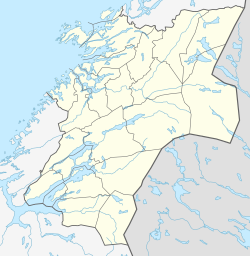Nord-Trøndelag
Nord-Trøndelag County
Nord-Trøndelag fylke | |
|---|---|
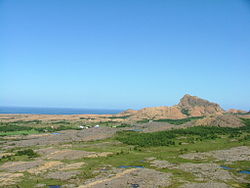 | |
|
| |
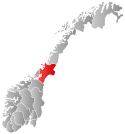 Nord-Trøndelag within Norway | |
| Coordinates:64°30′00″N11°40′00″E/ 64.50000°N 11.66667°E | |
| Country | Norway |
| County | Nord-Trøndelag |
| District | Trøndelag |
| Established | 1804 |
| •Preceded by | Trondhjems amt |
| Disestablished | 1 Jan 2018 |
| •Succeeded by | Trøndelagcounty |
| Administrative centre | Steinkjer |
| Government | |
| • Body | Nord-Trøndelag County Municipality |
| Area (upon dissolution) | |
| • Total | 22,412 km2(8,653 sq mi) |
| • Land | 20,777 km2(8,022 sq mi) |
| • Water | 1,635 km2(631 sq mi) 7.3% |
| • Rank | #6 in Norway |
| Population (2014) | |
| • Total | 135,142 |
| • Rank | #16 in Norway |
| • Density | 6/km2(20/sq mi) |
| • Change(10 years) | |
| Demonym | Nord-Trønder[1] |
| Official language | |
| •Norwegian form | Neutral |
| Time zone | UTC+01:00(CET) |
| • Summer (DST) | UTC+02:00(CEST) |
| ISO 3166 code | NO-17[3] |
| Income (per capita) | 122,100kr(2001) |
| GDP(per capita) | 194,803kr(2001) |
| GDPnational rank | #17 in Norway (1.63% of country) |
Nord-Trøndelag(Urban East Norwegian:[ˈnûːˌʈrœndəlɑːɡ];"North Trøndelag" ) was acountyconstituting the northern part of the present-dayTrøndelagcounty inNorway.It bordered the oldSør-Trøndelag( "South Trøndelag" ) county as well as the county ofNordland.To the west is theNorwegian Sea(Atlantic Ocean), and to the east isJämtlandinSweden.The county was established in 1804 when the oldTrondhjems amtwas divided into two: Nordre Trondhjems amt andSøndre Trondhjems amt.In 2016, the two county councils voted to merge (back) into a single county on 1 January 2018.[4]
As of 1 January 2014, the county had 135,142 inhabitants,[5]making it the country's fourth-least populated county. The largest municipalities areStjørdal,Steinkjer—the county seat,Levanger,Namsos,andVerdal,all with between 24,000 and 12,000 inhabitants. The economy is primarily centered on services, although there are significant industries in agriculture, fisheries, hydroelectricity and forestry. It has the lowestgross domestic productper capita of any county in the country.
Nord-Trøndelag covered 22,412 square kilometres (8,653 sq mi), making it the sixth-largest county, and it consisted of 23 municipalities. The district ofInnherredruns along the east side of theTrondheimsfjord,and is the most populated area, with much farming. To the south lies the district ofStjørdalen,while in the north, the larger district ofNamdalenstretches from theNorwegian Seato the mountains bordering Sweden. West of the Trondheimsfjord laysFosen.Nord-Trøndelag borderedSør-Trøndelagcounty to the south andNordlandcounty to the north. The western part of the county has several large valleys and consists largely of unpopulated wilderness, including fournational parks.Snåsavatnetis the largest lake, while major rivers includeNamsen,VerdalselvaandStjørdalselva.
Innherred was an important area during theViking Ageand featured theBattle of Stiklestad.The county was created in 1804 and was known as "Nordre Trondhjems amt" until 1919. Since the 1950s, the county has experienced a population growth below national levels. The axis north–south through the country pastGrongand along the west side of Trondheim Fjord is a main transport artery, including theEuropean Route E6and theNordland Line.
Geography
[edit]Nord-Trøndelag borderedNordlandto the north,Sør-Trøndelagto the south,Swedento the east and theNorwegian Seato the west. The county seat was thetown of Steinkjer,with 20,527 inhabitants (2005). The largest lake isSnåsavatnetand the largest river isNamsen,one of the bestsalmonrivers in Europe. Other well known salmon rivers are asVerdalselvaandStjørdalselva.Salsvatnetis the second-deepest lake in Europe, with a maximum depth of 482 metres (1,581 ft). Another lake in the area isByavatnet.Stjørdal is the biggest town in the county. There are local hospitals inLevangerandNamsos.
A large part of the population lives near the largeTrondheimsfjord,which is a central feature of the southern part of this county. In the north are other fjords, mainly theNamsenfjordandFoldafjord.Areas on the eastern and northeastern shore of Trondheimsfjord (mainly inStjørdal,Frosta,Levanger,Inderøy,VerdalandSteinkjer) are fertile agricultural lowland, withgrainfields andvegetables.Together with the grain fields in theNamdalenlowland, this forms the most northern grain cultivation area in Norway today.

However, the spruce dominated forest (some birch) covers a much larger area, and Nord-Trøndelag is the second largest timber producing county in Norway (afterHedmark). The forest and highland in Nord-Trøndelag is one of few places in Norway with four species ofdeer(moose, roe deer, red deer and reindeer). There are mountains near the border with Sweden, and coastal mountains with bare rock at the northern coast. The spruce forests occurs even at the coast, where some areas are classified astemperate rainforest(boreal rainforest, seeScandinavian coastal conifer forests). There are several national parks in the county, among themBlåfjella–Skjækerfjella National Park(one of the largest in Norway),Børgefjell National Park(partly),Lierne National ParkandSkarvan and Roltdalen National Park(partly).
History
[edit]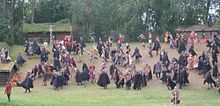
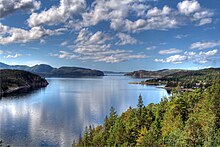



The first people in Nord-Trøndelag settled in Flatanger and Leka between 7500 and 6000 BCE, and were migrating northwards along the coast. In about the same time, people moved upwards along the Trondheimsfjord.[6]The first farmers migrated to Stjørdal around 2000 BCE in theStone Age.[7]Early agriculture was based mostly on animals, which allowed people to remain nomads and combine stockbreeding with gathering.[8]Around 2300 to 2000 BCE, the spruce spread into the county, and by 1300 CE, the landscape was dominated by spruce like today.[9]During the earlyBronze Age,from 1800 to 1000 BCE, the first large graves were built in the Trondheimsfjord area.[7]The earliest species of cereals grown wasbarleyaround 500 BCE, which was later supplemented with other cereals.[8]
In the first century CE, iron mining in swamps started in the easternmost parts of the country. Several small communities withblast furnaceswere established, located several days walk from the good agricultural land, generating trade and occupational specialization.[9]However, the mining industry stopped in the fifth century. In the following centuries, as part of the increased immigration due to theMigration Period,then a Germanic judicial system was introduced, which was a further development of the system launched during the mining era. In the fifth century, the first organizing of military took place, with constructions of small forts.[10]Around this time, the area was split into counties, with the current Nord-Trøndleag consisting of parts ofStjørdølafylke,Skøynafylke,Øynafylke,Verdølafylke,SparbyggjafylkeandNaumdølafylke.[11]From the tenth century, theFrostatingwas established as athingfor all of the Trondheimsfjord area.[12]
The largesthoffor worshipingNordic mythologywas atMæreand was a common site foranimal sacrifice.[13]In 997,Olaf TryggvasonestablishedNidaros(current-dayTrondheim), in Sør-Trøndelag, started a series of attacks to conquer Innherred. To counteract, the Innherred warlords established a marketplace in Steinkjer. In theBattle of Stiklestad,which took place in 1030, KingOlaf Haraldssonwas killed by a peasant army in a battle for supremacy over Trøndelag.[11]In the following decades, despite the defeat of the Christian Olaf, Trøndelag was gradually Christianized, resulting in the construction of churches[14]and two monasteries.[15]By the 13th century, the Frostating laws had been codified, by which time all of Central Norway was under the thing, which developed into a court, which was moved to Nidaros in the 16th century.[16]
During theViking Age,the population increased, reaching 20,000 by the mid-13th century. TheBlack Deathkilled off many people, and Nordli and Meråker were depopulated.[17]Sami peopleimmigrated from the north in the following two centuries.[18]Archbishop of Nidaros,Olav Engelbrektsson,started building a fortress inSteinvikholmenin Stjørdal, which was completed in 1532, and became the center of the archdiocese. It remained until theProtestant Reformationin 1537, in which the king took over all church assets in the country, which consisted of nearly 40% of the land. Subsequently, the number of self-owning farmers increased.[19]The 16th century also saw the beginning of export of fish and lumber, and the first sawmills were established.[20]In the 17th century, administration gradually shifted from that of warlords tovogt,a representative of the king inCopenhagen.Taxes were increased to finance the military, and in Nord-Trøndelag, farmers had to join the military to fight Sweden inJämtland.[21]
In the 18th century,confirmationand schools were introduced, and the potato was introduced during the 1770s. Parts of Namdalen was the target of immigrants fromEastern Norway,who cleared new land. In 1804,Trondhjems amtwas split into two, with the northern part becoming Nordre Trondhjems amt. In 1919, it changed its name to Nord-Trøndelag. In 1838, the municipalities were created, and Nordre Trondhjems amt received 18.[22]In 1836, Levanger received status as a market-town, followed by Namsos in 1845 and Steinkjer in 1857.[23]The number would gradually increase to 48.[24]
In 1851,Marcus Thrane's public meetings caused riots demanding increased labor rights.[22]The first steam-powered sawmill was established atSpillumin 1853, and forestry started becoming a profession, rather than a part-time work during the winter. From the late 18th century, sail ships started running in regular traffic along the coast and in the fjord to Trondheim. Most natural resources were owned by the burgoise in Trondheim, as royal concession was needed for any exploitation.[20]During the last half of the 19th century, tens of thousands of people emigrated to North America, with some communities losing just under half their population.[23]
Industrializationstarted in the 1838 withsteamshipsin regular traffic along the coast, and later on Trondheimsfjord and Snåsavatnet. At the end of the 19th century, theGreat Transformationtook place, whereby the economy changed from being predominantly based on self-production to a professional trades.Croftswere abolished. TheMeråker LinereachedHellin 1881, and in 1905 theHell–Sunnan LinereachedSunnan.[25]The first flight took off from Værnes in 1914, and in 1948 scheduled services were started toOslo.[26]
Demographics
[edit]| Year | Pop. | ±% |
|---|---|---|
| 1951 | 109,948 | — |
| 1961 | 116,760 | +6.2% |
| 1971 | 117,998 | +1.1% |
| 1981 | 125,835 | +6.6% |
| 1991 | 127,226 | +1.1% |
| 2001 | 127,261 | +0.0% |
| 2011 | 132,140 | +3.8% |
| Source:Statistics Norway.[27] | ||
As of 2010, Nord-Trøndelag had 131,555 inhabitants.[30]There were 55,910 households, or 2.3 people per household.[31]Life expectancyis 77.7 years for males and 82.4 years for females, both above the national average.[32]There were 5,942 foreigners, or 4.5%, including Norwegian-born to immigrant parents.[33]There were 4,699 people with foreign citizenship, the lowest for any county both in relative and absolute numbers.[34]The largest sources of immigration are Eastern Europe and Asia.[33]
Christianity is the dominant religion. As of 2010, 5,061 (3.8%) people were not registered as members of theChurch of Norway.Of these, 2,581 (1.9%) were members of other Christian groups, while 1,762 (1.3%) were irreligious, 508 (0.3%) were Muslims, 158 were Buddhists, and 52 belonged to other religions.[35]
Trønderskis a dialect ofNorwegianwhich with minor modifications is spoken throughout Trøndelag andNordmøre.[36][citation not found]It is characterized by the use ofapocope,[36][citation not found]palatalization[37][citation not found]andretroflex flaps(thick "L" ).[36][citation not found]The Trøndersk spoken in Nord-Trøndelag is broader and closer toOld Norsethan what is spoken in Trondheim, with the broadest language being spoken in Innherred. The towns in Nord-Trøndelag have been more influenced by written Norwegian andStandard Østnorskand have a less broad dialect. Compared to Sør-Trøndelag, there is a tendency ofutjamningrather thantiljamning.The use ofdative caseis gradually disappearing. About 300 Sami people,[38]which are concentrated around Snåsa, speak theSouthern Sami language.It is notmutually intelligiblewith other Sami languages, and belongs toUralic,a differentlanguage familythan Norwegian.[39]
Government
[edit]Nord-Trøndelag County Municipalityruns 3,000 kilometers (1,900 mi) of county roads,[40]public transport,[41]eleven upper secondary schools with 7,000 pupils,[42]regional development and other minor issues.[43]The county municipality is led by a 35-membercounty council,which in the2007 electionhas consisted of members of seven parties.[44]The administration is led by acounty cabinetwith six members, representing theLabour Party,theConservative Party,theLiberal Partyand theChristian Democratic Party.The cabinet is led byAlf Daniel Moenof the Labour Party,[45]whileGunnar Vikenof the Conservative Party is county mayor.[46]
TheNord-Trøndelag County Governoris the state's representative in the county. Since 2009, the governor has beenInge Ryan,a former parliamentarian for theSocialist Left Party.[47]The county is covered by threedistrict courts,Inderøy District Court,located in Steinkjer,[48]Stjør- and Verdal District Courtin Levanger,[49]andNamdal District Courtin Namsos.[50]All are subordinateFrostating Court of Appeal.[51]The county is covered by Nord-Trøndelag Police District.[52]
Nord-Trøndelag also constitutes anelectoral districtfor theParliament of Norway,consisting of six representatives. In the2009 election,the Labour Party received three representatives,Gerd Janne Kristoffersen,Arild Stokkan-GrandeandSusanne Bratli,in addition toRobert Erikssonof theProgress Party,Lars Peder Brekkof theCentre Party,andLars Myrauneof the Conservative Party.[53]Since 2008, Brekk has beenMinister of Agriculture and Food.[54]
Economy
[edit]
In 2007, Nord-Trøndelag had a gross domestic product (GDP) per capita NOK 242,895 and an income per capita of NOK 165,075, less than any other Norwegian county. For GDP per capita, Nord-Trøndelag lay at 67% of the national average, excluding thecontinental shelf,and lay just above a third ofOslo.[55]
Agriculture is most common east of the Trondheimsfjord, the lower parts of Indre Namdal and Nærøy.[56]876 square kilometers (338 sq mi) of land is used for agriculture, of which 310 square kilometers (120 sq mi) iscereals,[57]which is more dominant along the Trondheimsfjord.[58]The county has ten percent of the country's agricultural output, and no other county has so high a percentage of its production from farming.[59]Farms traditionally have a square lot of buildings, with the house, called atrønderlån,being thin and long.[58]Fishing is an important industry along the coast, particularly in Ytre Namdal,[60]and Trondheim Fjord is the fjord with the highest yield in Norway.[61]Fish farming,particularly ofsalmon,has seen a rapid growth since the 1970s. Most of the fish is exported to Continental Europe, and to a less degree the Far East.[62]
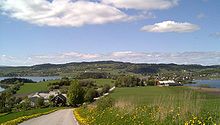
Forty percent of the county is covered byforest,but about half of it is not profitable to log.[63]Parts of the forests are preserved, including the Coastal Spruce Forest, which is the only place in Europe wheresprucegrows out to the coast.[64]Up to 800,000 cubic meters (28,000,000 cu ft) of lumber is harvested each year, of which 95% is spruce and 3% ispine.[65]Statskog,a government agency, owns 7,330 square kilometres (2,830 sq mi) of Nord-Trøndelag, of which1,068 square kilometers (412 sq mi) is productive forest.[66]Large private forest owners includeVærdalsbruketandMeraker Brug,while municipalities own 178 square kilometers (69 sq mi).[67]Norske Skog Skogn,established in 1962 and located atSkogn,is one of the largest companies in the county, and among Europe's largest producers ofnewsprint.[68]Södra Cell FollainFollafossis a producer ofpulp.[69]
Hydroelectricityproduction in Nord-Trøndelag is for 2.9 TWh per year, all of which is owned byNord-Trøndelag Elektrisitetsverk(NTE). Owned by the county municipality and established in 1919,[70]it also operates twowind farms,ViknaandHundhammerfjellet.[71]Aker Verdalmanufacturers jackets foroil platforms;established in 1976, it is among the largest employers in the county.[72]
Culture
[edit]

The county had fourfolk high schools:Sund,Namdal,SkognandBakketun.[73]The state-ownedNord-Trøndelag University Collegehas campuses in Levanger, Steinkjer, Stjørdal and Namsos, and provides undergraduate education to 4,460 pupils.[74]TheCentral Norway Regional Health Authorityis based in Stjørdal,[75]and its subsidiaryNord-Trøndelag Hospital Trustoperates two hospitals,LevangerandNamsos.[76]
The traditional cuisine consisted of five meals per day, and containedherring,porridge,dairy productsand flat bread, with the potato coming into use during the 19th century. Herring and potato became the standard meal for commoners.[77]Local specialties includeginger ale,akvavit,sodd,while it was common to usegrævfiskandrakfisk(raw rotten fish) in the mountainous areas.[78]
Nord-Trøndelag Teater,located in Verdalsøra, is the only all-year professional theater.[79]Since 1954,The Saint Olav Dramahas been performed atStiklestad,portraying the battle.[80]Similarly, an outdoor midnight opera is held on Steinvikholmen portraying the historical events there.[81]Amateurrevueis popular, and the Norwegian Revue Festival is held in Høylandet every other year.[82]Three bandsÅge Aleksandersen,Hans RotmoandDDEare the most successful music artists, having created the genre trønderrock. The former two had their breakthrough in the 1970s, while the latter had it in the 1990s.[83]Levanger HKplays in Premier Women's Handball League.[84]Saemien Sijte,located in Snåsa, is a center forSami culture.
Trønder-Avisa,published in Steinkjer, is the only county-widenewspaper,although the Trondheim-basedAdresseavisenalso covers the county.Namdalsavisa,published in Namsos, covers Namdalen. Local newspapers, most of which cover a single municipality, areFrostingen,Inderøyningen,Innherreds Folkeblad og Verdalingen,Levanger-Avisa,Lokalavisa Verran Namdalseid,Meråkerposten,Snåsningen,Steinkjer-Avisa,Stjørdalens BladandYtringen.[85]TheNorwegian Broadcasting Corporationhas offices in Steinkjer and runs radio programs exclusively for the county.
Transport
[edit]
European Route E6runs north–south throughout eastern part the county, partially as amotorway.This route runs from Stjørdal via Steinkjer and Grong to Nordland. Other important routes in the county includeE14between Stjørdal via Meråker to Sweden, andCounty Road 17from Steinkjer via Namsos and Nærøy to Nordland.[40]Both passenger and car ferries operate on the coast, and in Trondheimsfjord is theLevanger–Hokstad Ferry.[86]Private road transport is dominant, aspublic transportis sparsely operated. The largest bus company isTrønderBilene.[87]
TheNordland Lineis a railway that runs from Trondheim toBodø,and it runs north–south through the county.[25]South of Steinkjer, theTrøndelag Commuter Railoperates to Trondheim.[87]There are also two other lines; theMeråker Line,part of the line between Trondheim andStockholmruns from Stjørdal to Meråker and onwards to Sweden.[25]TheNamsos Lineis purely used for freight and goes from Grong to Namsos.[88]All the railways are unelectrified.Trondheim Airport, Værnes,Norway's third-largestairportis located inStjørdal,and serves most major airports in Norway, as well as European destinations. There are tworegional airports,Namsos Airport, HøknesøraandRørvik Airport, Ryum.[86]TheCoastal Expressferry service calls atRørvik.[89]
Municipalities
[edit]
Nord-Trøndelag has 23 municipalities as shown in the map.
| Municipality | Population | Area (km2) |
Area (sqmi) |
Center | Ref |
|---|---|---|---|---|---|
| Flatanger | 1,104 | 434.8 | 167.9 | Lauvsnes | [90] |
| Fosnes | 670 | 474.6 | 183.2 | Jøa | [91] |
| Frosta | 2,495 | 74.3 | 28.7 | Frosta | [92] |
| Grong | 2,361 | 1,114.3 | 430.2 | Medjå | [93] |
| Høylandet | 1,270 | 705.2 | 272.3 | Høylandet | [94] |
| Inderøy | 5,897 | 145.1 | 56.0 | Sakshaug | [95] |
| Leka | 593 | 108.0 | 41.7 | Leknes | [96] |
| Leksvik | 3,528 | 400.2 | 154.5 | Leksvik | [97] |
| Levanger | 18,580 | 611.3 | 236.0 | Levanger | [98] |
| Lierne | 1,435 | 2,640.0 | 1,019.3 | Sandvika | [99] |
| Meråker | 2,471 | 1,273.4 | 491.7 | Midtbygda | [100] |
| Nærøy | 4,990 | 1,013.5 | 391.3 | Kolvereid | [101] |
| Namdalseid | 1,697 | 737.9 | 284.9 | Namdalseid | [102] |
| Namsos | 12,795 | 757.1 | 292.3 | Namsos | [103] |
| Namsskogan | 928 | 1,368.1 | 528.2 | Namsskogan | [104] |
| Overhalla | 3,577 | 699.0 | 269.9 | Ranemsletta | [105] |
| Røyrvik | 495 | 1,334.6 | 515.3 | Røyrvik | [106] |
| Snåsa | 2,164 | 2,160.4 | 834.1 | Snåsa | [107] |
| Steinkjer | 21,080 | 1,427.5 | 551.2 | Steinkjer | [108] |
| Stjørdal | 21,375 | 919.8 | 355.1 | Stjørdalshalsen | [109] |
| Verdal | 14,222 | 1,488.5 | 574.7 | Verdalsøra | [110] |
| Verran | 2,914 | 558.5 | 215.6 | Malm | [111] |
| Vikna | 4,122 | 310.2 | 119.8 | Rørvik | [112] |
References
[edit]- ^"Navn på steder og personer: Innbyggjarnamn"(in Norwegian). Språkrådet.
- ^"Forskrift om målvedtak i kommunar og fylkeskommunar"(in Norwegian). Lovdata.no.
- ^Bolstad, Erik; Thorsnæs, Geir, eds. (26 January 2023)."Kommunenummer".Store norske leksikon(in Norwegian).Kunnskapsforlaget.
- ^Hofstad, Sigrun (27 April 2016)."Her bankes det for et samlet Trøndelag"(in Norwegian). NRK.
- ^"Færre flyttar til Noreg".ssb.no.Retrieved3 April2018.
- ^Aune 1995,p. 39
- ^abAune 1995,p. 43
- ^abAune 1995,p. 45
- ^abAune 1995,p. 46
- ^Aune 1995,p. 48
- ^abAune 1995,p. 64
- ^Aune 1995,p. 62
- ^Aune 1995,p. 54
- ^Aune 1995,p. 57
- ^Aune 1995,p. 60
- ^Aune 1995,p. 63
- ^Aune 1995,p. 65
- ^Aune 1995,p. 196
- ^Aune 1995,p. 68
- ^abAune 1995,p. 70
- ^Aune 1995,p. 72
- ^abAune 1995,p. 76
- ^abAune 1995,p. 74
- ^Aune 1995,p. 248
- ^abcAune 1995,p. 77
- ^Aune 1995,p. 79
- ^"Statistikkbanken".ssb.no.26 May 2012. Archived fromthe originalon 23 October 2013.Retrieved3 April2018.
- ^Statistics Norway – Church of Norway.Archived16 July 2012 atarchive.today
- ^"Statistics Norway – Members of religious and life stance communities outside the Church of Norway, by religion/life stance. County. 2006–2010".ssb.no.Retrieved3 April2018.
- ^"Population, by age and county. Absolute figures. 1 January 2010".Statistics Norway.Retrieved22 December2010.
- ^"Private households and persons per private household, by county. 1960, 1970, 1980, 1990, 2001 and 2010".Statistics Norway.Retrieved22 December2010.
- ^"Life expectancy – remaining years for males and females at selected ages, by county".Statistics Norway.Retrieved22 December2010.
- ^ab"Life expectancy – remaining years for males and females at selected ages, by county".Statistics Norway.Archived fromthe originalon 15 November 2011.Retrieved22 December2010.
- ^"Foreign citizens. Number and as a percentage of population, by county. 1 January 1976–2010".Statistics Norway.Retrieved22 December2010.
- ^"Members of religious and life stance communities outside the Church of Norway, by religion/life stance".Statistics Norway.
- ^abcHalvorsen, Jemterud & Semmen 2000,p. 398
- ^Halvorsen, Jemterud & Semmen 2000,p. 404
- ^"Saami, South".Ethnologue.Retrieved3 January2011.
- ^Aune 1995,p. 203
- ^ab"Veg"(in Norwegian).Nord-Trøndelag County Municipality.Archived fromthe originalon 26 March 2012.Retrieved22 December2010.
- ^"Kollektivtrafikk"(in Norwegian).Nord-Trøndelag County Municipality.Retrieved22 December2010.
- ^"Utdanning"(in Norwegian).Nord-Trøndelag County Municipality.Archived fromthe originalon 14 January 2012.Retrieved22 December2010.
- ^"Regional utvikling"(in Norwegian).Nord-Trøndelag County Municipality.Retrieved22 December2010.
- ^"Medlemmer"(in Norwegian).Nord-Trøndelag County Municipality.Archived fromthe originalon 12 December 2010.Retrieved22 December2010.
- ^"Fylkesrådet"(in Norwegian).Nord-Trøndelag County Municipality.Archived fromthe originalon 26 September 2015.Retrieved22 December2010.
- ^"Fylkesordfører"(in Norwegian).Nord-Trøndelag County Municipality.Archived fromthe originalon 28 December 2014.Retrieved22 December2010.
- ^"Om fylkesmannen"(in Norwegian). Nord-Trøndelag County Governor.Retrieved22 December2010.
- ^"Inderøy tingrett"(in Norwegian).Norwegian National Courts Administration.Retrieved22 December2010.
- ^"Stjør- og Verdal tingrett"(in Norwegian).Norwegian National Courts Administration.Retrieved22 December2010.
- ^"Namdal tingrett"(in Norwegian).Norwegian National Courts Administration.Retrieved22 December2010.
- ^"Frostating lagmannsrett"(in Norwegian).Norwegian National Courts Administration.Retrieved22 December2010.
- ^"Nord-Trøndelag politidistrikt"(in Norwegian).Norwegian Police Service.Retrieved22 December2010.
- ^"Dagens møtende"(in Norwegian).Parliament of Norway.Retrieved22 December2010.
- ^"Brekk, Lars Peder"(in Norwegian).Parliament of Norway.Retrieved22 December2010.
- ^Statistics Norway."BNP per sysselsatt høyest i Oslo"(in Norwegian).Retrieved26 October2009.
- ^Aune 1995,p. 137
- ^"Jordbruksareal, etter fylke og bruken av arealet"(in Norwegian).Statistics Norway.Retrieved22 December2010.
- ^abAune 1995,p. 139
- ^Aune 1995,p. 131
- ^Aune 1995,p. 101
- ^Aune 1995,p. 102
- ^Aune 1995,p. 108
- ^Aune 1995,p. 147
- ^Aune 1995,p. 148
- ^Aune 1995,p. 149
- ^Aune 1995,pp. 152–153
- ^Aune 1995,p. 154
- ^Aune 1995,p. 155
- ^Aune 1995,p. 238
- ^Aune 1995,p. 235
- ^"Vindkraft"(in Norwegian).Nord-Trøndelag Elektrisitetsverk.Archived fromthe originalon 29 September 2011.Retrieved22 December2010.
- ^Aune 1995,p. 239
- ^Aune 1995,p. 234
- ^"English".Nord-Trøndelag University College.Retrieved22 December2010.
- ^"Ledelse"(in Norwegian).Central Norway Regional Health Authority.Archived fromthe originalon 9 June 2010.Retrieved22 December2010.
- ^"Helse Nord-Trøndelag"(in Norwegian).Central Norway Regional Health Authority.Archived fromthe originalon 14 January 2011.Retrieved22 December2010.
- ^Aune 1995,p. 119
- ^Aune 1995,p. 121
- ^"Om teatret".Nord-Trøndelag Teater.Archived fromthe originalon 24 December 2010.Retrieved22 December2010.
- ^Aune 1995,p. 161
- ^Aune 1995,p. 162
- ^Aune 1995,p. 163
- ^Aune 1995,p. 176
- ^"Postenligaen Kvinner, sesongen 1011".Norwegian Handball Federation.Retrieved22 December2010.
- ^"MEideregisteret".Norwegian Media Authority.Retrieved22 December2010.[permanent dead link]
- ^abAune 1995,p. 186
- ^abAune 1995,p. 189
- ^Aune 1995,p. 78
- ^Aune 1995,p. 187
- ^Statistics Norway."Tall om Flatanger kommune"(in Norwegian).Retrieved26 December2010.
- ^Statistics Norway."Tall om Fosnes kommune"(in Norwegian).Retrieved26 December2010.
- ^Statistics Norway."Tall om Frosta kommune"(in Norwegian).Retrieved26 December2010.
- ^Statistics Norway."Tall om Grong kommune"(in Norwegian).Retrieved26 December2010.
- ^Statistics Norway."Tall om Flatanger kommune"(in Norwegian).Retrieved26 December2010.
- ^Statistics Norway."Tall om Inderøy kommune"(in Norwegian).Retrieved26 December2010.
- ^Statistics Norway."Tall om Leka kommune"(in Norwegian).Retrieved26 December2010.
- ^Statistics Norway."Tall om Leksvik kommune"(in Norwegian).Retrieved26 December2010.
- ^Statistics Norway."Tall om Levanger kommune"(in Norwegian).Retrieved26 December2010.
- ^Statistics Norway."Tall om Lierne kommune"(in Norwegian).Retrieved26 December2010.
- ^Statistics Norway."Tall om Meråker kommune"(in Norwegian). Archived fromthe originalon 1 October 2007.Retrieved26 December2010.
- ^Statistics Norway."Tall om Nærøy kommune"(in Norwegian).Retrieved26 December2010.
- ^Statistics Norway."Tall om Namdalseid kommune"(in Norwegian).Retrieved26 December2010.
- ^Statistics Norway."Tall om Namsos kommune"(in Norwegian).Retrieved26 December2010.
- ^Statistics Norway."Tall om Namsskogan kommune"(in Norwegian).Retrieved26 December2010.
- ^Statistics Norway."Tall om Overhalla kommune"(in Norwegian).Retrieved26 December2010.
- ^Statistics Norway."Tall om Røyrvik kommune"(in Norwegian).Retrieved26 December2010.
- ^Statistics Norway."Tall om Snåsa kommune"(in Norwegian).Retrieved26 December2010.
- ^Statistics Norway."Tall om Steinkjer kommune"(in Norwegian).Retrieved26 December2010.
- ^Statistics Norway."Tall om Stjørdal kommune"(in Norwegian).Retrieved26 December2010.
- ^Statistics Norway."Tall om Verdal kommune"(in Norwegian).Retrieved26 December2010.
- ^Statistics Norway."Tall om Verran kommune"(in Norwegian).Retrieved26 December2010.
- ^Statistics Norway."Tall om Vikna kommune"(in Norwegian).Retrieved26 December2010.
- Bibliography
- Aune, Tormod (1995).Hilsen Nord-Trøndelag(in Norwegian). Namsos: Trønderbok.ISBN82-993613-0-3.



